科陆智慧能源云平台介绍 - V7
- 格式:pptx
- 大小:507.80 KB
- 文档页数:12
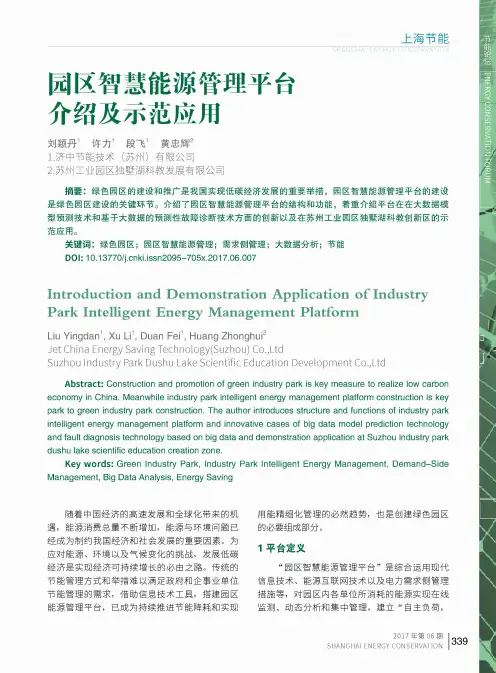
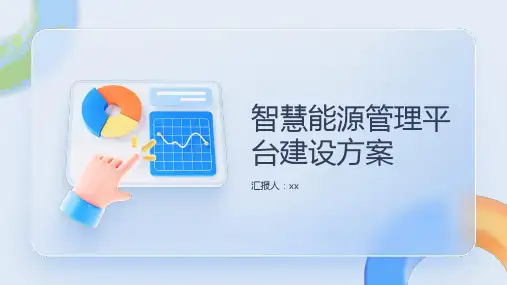
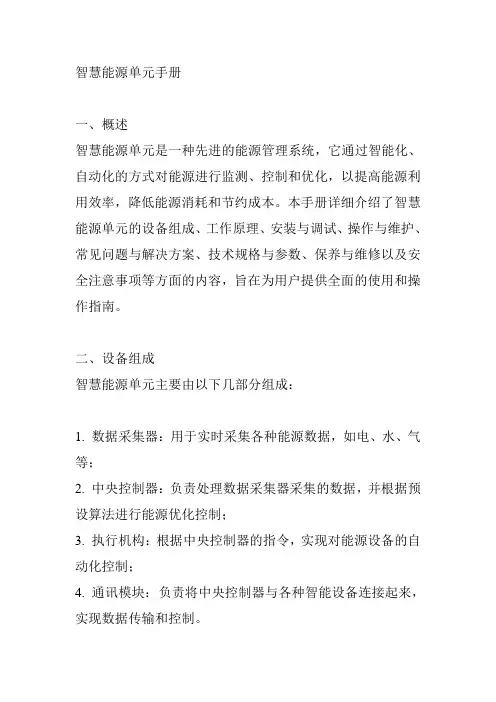
智慧能源单元手册一、概述智慧能源单元是一种先进的能源管理系统,它通过智能化、自动化的方式对能源进行监测、控制和优化,以提高能源利用效率,降低能源消耗和节约成本。
本手册详细介绍了智慧能源单元的设备组成、工作原理、安装与调试、操作与维护、常见问题与解决方案、技术规格与参数、保养与维修以及安全注意事项等方面的内容,旨在为用户提供全面的使用和操作指南。
二、设备组成智慧能源单元主要由以下几部分组成:1. 数据采集器:用于实时采集各种能源数据,如电、水、气等;2. 中央控制器:负责处理数据采集器采集的数据,并根据预设算法进行能源优化控制;3. 执行机构:根据中央控制器的指令,实现对能源设备的自动化控制;4. 通讯模块:负责将中央控制器与各种智能设备连接起来,实现数据传输和控制。
三、工作原理智慧能源单元通过数据采集器实时采集各种能源数据,并将数据传输到中央控制器。
中央控制器对数据进行处理和分析,根据预设算法进行能源优化控制,并生成控制指令发送给执行机构。
执行机构根据指令对能源设备进行自动化控制,实现能源的智能管理。
同时,智慧能源单元还可以通过通讯模块与智能设备进行数据交换,实现远程监控和控制。
四、安装与调试在安装和调试智慧能源单元时,请遵循以下步骤:1. 确定安装位置,确保设备可以覆盖所需监控的区域;2. 按照设备清单检查所需配件是否齐全,并按照说明书进行组装;3. 连接电源、信号线等,确保线路连接正确;4. 进行设备调试,检查各项功能是否正常;5. 根据实际情况调整设备参数,以实现最佳的能源管理效果。
五、操作与维护在使用和维护智慧能源单元时,请注意以下几点:1. 定期检查设备外观,确保无破损或异常;2. 定期清理设备表面灰尘和杂物,保持清洁;3. 定期检查线路连接是否牢固,如有松动应及时紧固;4. 根据实际情况调整设备参数,以实现最佳的能源管理效果;5. 如发现设备故障或异常情况,应及时联系专业人员进行检修。
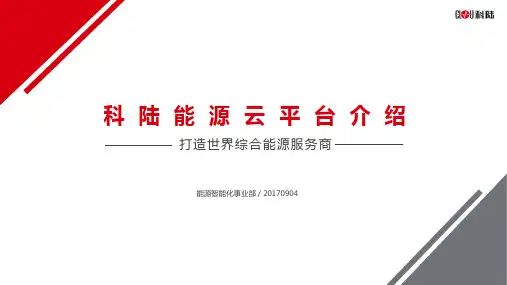

智慧能源平台规划方案智慧能源平台是指运用现代信息技术手段,集中管理和调度能源生产、传输、储存与消费等各环节的平台,旨在提高能源利用效率、优化能源配置,实现能源供应的可持续发展。
下面是一份智慧能源平台的规划方案,共分为四个方面来详细介绍。
一、基础设施建设1. 电力自动化改造:利用物联网和大数据技术,对电网进行升级改造,实现对电力设备的远程监控和智能管理,提高供电可靠性和供电质量。
2. 能源储存设施建设:建设能源储存设施,包括电池、储气罐等,以实现能源的稳定供应和调峰能力,减少能源浪费。
3. 智能电网建设:建设智能电网,通过物联网技术实现对电力设备状态、负荷信息的实时监测和调控,提高电网的运行效率和可靠性。
4. 光伏发电设施建设:加强光伏发电设施建设,利用太阳能资源进行电力生产,减少对传统能源的依赖,推动绿色能源的发展。
二、数据采集和分析1. 数据采集:通过传感器和物联网技术,对能源生产、传输、储存和消费等各环节的数据进行实时采集,包括能源生产量、负荷变化、能源储存情况等。
2. 数据传输:建设高速通信网络,实现对采集数据的实时传输和共享,以保证数据的准确性和及时性。
3. 数据分析:利用大数据分析技术,对采集的数据进行深入分析,提取有价值的信息,包括能源消费趋势、能源利用效率等,为能源管理和调度决策提供科学依据。
三、能源管理和调度1. 能源管理平台建设:建设能源管理平台,对能源生产、传输、储存和消费等各环节的数据进行集中管理和监控,实现对能源的全面管理和调度。
2. 能源调度策略优化:利用智能算法和优化模型,对能源调度策略进行优化,包括供应链管理、负荷预测、能源储备和调峰等,提高能源利用效率和调度的准确性。
3. 能源节约措施推广:通过能源管理平台的数据分析和监控,及时发现能源浪费和不合理使用的问题,并采取相应的节约措施,减少能源浪费。
4. 能源市场化运营:建立能源市场化运营机制,通过市场机制来调控能源供求,提高整体能源市场的竞争力和效益。

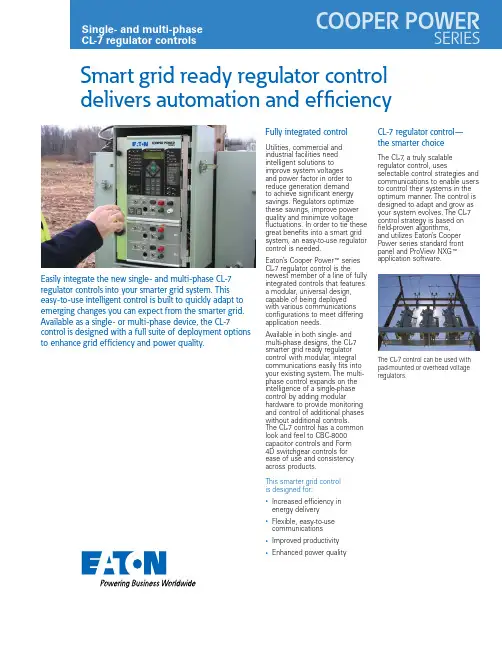
Smart grid ready regulator control delivers automation and efficiencyEasily integrate the new single- and multi-phase CL-7 regulator controls into your smarter grid system. This easy-to-use intelligent control is built to quickly adapt to emerging changes you can expect from the smarter grid. Available as a single- or multi-phase device, the CL-7 control is designed with a full suite of deployment options to enhance grid efficiency and power quality. Fully integrated controlUtilities, commercial andindustrial facilities needintelligent solutions toimprove system voltagesand power factor in order toreduce generation demandto achieve significant energysavings. Regulators optimizethese savings, improve powerquality and minimize voltagefluctuations. In order to tie thesegreat benefits into a smart gridsystem, an easy-to-use regulatorcontrol is needed.Eaton’s Cooper Power E seriesCL-7 regulator control is thenewest member of a line of fullyintegrated controls that featuresa modular, universal design,capable of being deployedwith various communicationsconfigurations to meet differingapplication needs.Available in both single- andmulti-phase designs, the CL-7smarter grid ready regulatorcontrol with modular, integralcommunications easily fits intoyour existing system. The multi-phase control expands on theintelligence of a single-phasecontrol by adding modularhardware to provide monitoringand control of additional phaseswithout additional controls.The CL-7 control has a commonlook and feel to CBC-8000capacitor controls and Form4D switchgear controls forease of use and consistencyacross products.This smarter grid controlis designed for:• Increased efficiency inenergy delivery• Flexible, easy-to-usecommunications• Improved productivity• Enhanced power qualityCL-7 regulator control—the smarter choiceThe CL-7, a truly scalableregulator control, usesselectable control strategies andcommunications to enable usersto control their systems in theoptimum manner. The control isdesigned to adapt and grow asyour system evolves. The CL-7control strategy is based onfield-proven algorithms,and utilizes Eaton’s CooperPower series standard frontpanel and ProView NXG Eapplication software.The CL-7 control can be used withpad-mounted or overhead voltageregulators.The CL-7 control (single-phase panel shown) is easily integrated intoa variety of systems and applications.Flexible, easy-to-use communicationsThe CL-7 control is specifically designed for remote operation and retrieval of field measurement data for analysis by integrated volt/var applications. Benefits from this highly flexible and programmable control include:• Easy integration into radio networks and SCADA systems using a variety of communication radios and modems• Communication loss fail-safe modes for grid stability• Unsolicited reporting of state change, field alarms or threshold violations for easy monitoring• Available radio-ready• Increased security with password protection• Control configurations upgradable or downloadable through Eaton’s ProView NXG software• Locally utilizing the control’s USB connection• Remotely from office using radio communications• Meets IEC standards supporting 120/240 V and 50/60 Hz electrical systems for global applications• Single access point communications for all three phaseswith multi-phase control Whether on a new installation or retrofit (as shown above), the CL-7 three-phase control is easily programmed in the field.Improved productivityReduce time in the field and operating costs with remote control, scanning, programming and data log downloads overa secure network.• Remote, over-the-air settings updates:• Simplified installation• Less training needed• Highly flexible operational settings• Remote retrieval of data:• Engineers can select nearly 400 data points• Data logged into data log/sequence of events (SOE) Three-phase power quality measurements with one multi-phase CL-7 control• Monitors every aspect of site’s health with full three-phase voltage, current, var and harmonic monitoring as well as monitoring via analog inputs for greater accuracy• Offers refined power quality event monitoring—in the event of problems or grid anomalies that may need detailed analysis• Monitors and improves power quality• Allows customizable solutions to system imbalance withadvanced features 2EATON Single- and multi-phase CL-7 regulator controlsDistribution automation solutionEaton offers the full suite of power quality software and apparatus to support your volt/var management solution. With unparalleled expertise to make your automation seamless we offer:• CBC-8000 capacitor bank control• Yukon E Volt/Var management automation software• Capacitor banks• CL-7 voltage regulator controls• Voltage regulatorsOptimal feeder voltageYukon Volt/Var Control (IVVC) software uses capacitors and regulators to flatten the feeder voltage profile. The regulator works in conjunction with the capacitor to deliver the optimal feeder voltage profile. The graph below represents the Yukon IVVC software flattening the voltage profile—resulting in a reduction in bus voltage from 122 to 118 volts.Power factor correctionPower factor correction is a crucial element in improving energy efficiency and reducing losses. Regulators are used to correct the distribution feeder voltage. The graph below represents before and after effective implementation of Yukon Volt/Var management software.Power system studies for optimized resultsMaximize the benefits from implementing a volt/var management application with Eaton’s CYME E Engineering Services team.We offer power system studies to identify the best combination of regulation equipment to optimize feeder voltage profiles and substation var management.3 EATON Single- and multi-phase CL-7 regulator controlsEaton is a registered trademark.All other trademarks are property of their respective owners.Eaton1000 Eaton Boulevard Cleveland, OH 44122United States Eaton's Power Systems Division 2300 Badger Drive Waukesha, WI 53188United States/cooperpowerseries © 2016 EatonAll Rights Reserved Printed in USAPublication No. PA225006EN / Z18959Supersedes B225-12089December 2016For Eaton’s Cooper Power series product information, visit/cooperpowerseriesThe CL -7 control is specifically designed to operate voltage regulating apparatus. This highly flexible control can be deployed in a number of operational strategies using site metrics that include voltage and current.Key operating features• Single- or multi-phase control •Local or remote control of regulators• Multiple operating profiles •Fully programmablepreventative maintenance tools•Battery backup options to maintain communicationsKey two-waycommunication features• Single-access communications • Real-time scanning • Site alarm notifications •Radio-ready controlA Left-side LEDs to indicateregulator functionality B USB data portsC Ten-key programming area with LCD displayD Right-side LEDs to indicate control informationE Metering-PLUS E legend FBottom color-coded area foroperating the controlG Additional manual controls for multi-phase applications H Communication status LEDs I External power source and voltmeter test terminals123456789Follow us on social media to get the latest product and support information.。
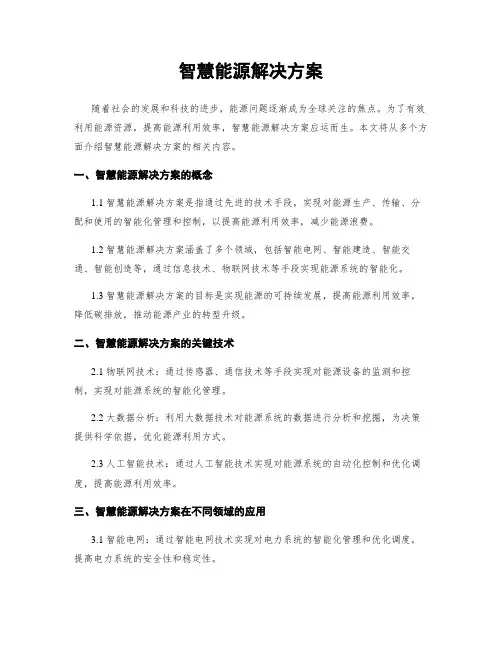
智慧能源解决方案随着社会的发展和科技的进步,能源问题逐渐成为全球关注的焦点。
为了有效利用能源资源,提高能源利用效率,智慧能源解决方案应运而生。
本文将从多个方面介绍智慧能源解决方案的相关内容。
一、智慧能源解决方案的概念1.1 智慧能源解决方案是指通过先进的技术手段,实现对能源生产、传输、分配和使用的智能化管理和控制,以提高能源利用效率,减少能源浪费。
1.2 智慧能源解决方案涵盖了多个领域,包括智能电网、智能建造、智能交通、智能创造等,通过信息技术、物联网技术等手段实现能源系统的智能化。
1.3 智慧能源解决方案的目标是实现能源的可持续发展,提高能源利用效率,降低碳排放,推动能源产业的转型升级。
二、智慧能源解决方案的关键技术2.1 物联网技术:通过传感器、通信技术等手段实现对能源设备的监测和控制,实现对能源系统的智能化管理。
2.2 大数据分析:利用大数据技术对能源系统的数据进行分析和挖掘,为决策提供科学依据,优化能源利用方式。
2.3 人工智能技术:通过人工智能技术实现对能源系统的自动化控制和优化调度,提高能源利用效率。
三、智慧能源解决方案在不同领域的应用3.1 智能电网:通过智能电网技术实现对电力系统的智能化管理和优化调度,提高电力系统的安全性和稳定性。
3.2 智能建造:利用智能建造技术实现对建造能源系统的智能化控制,减少能源浪费,提高建造能效。
3.3 智能交通:通过智能交通技术实现对交通系统的智能化管理和优化调度,减少交通拥堵和尾气排放。
四、智慧能源解决方案的优势和挑战4.1 优势:提高能源利用效率,减少能源浪费,降低碳排放,推动能源产业的可持续发展。
4.2 挑战:技术成本高、系统集成难度大、数据安全风险等问题是智慧能源解决方案面临的挑战。
4.3 发展趋势:随着技术的不断进步和应用场景的不断丰富,智慧能源解决方案将逐渐成为能源领域的主流发展方向。
五、智慧能源解决方案的未来展望5.1 智慧能源解决方案将在未来得到更广泛的应用,为实现能源的可持续发展和碳中和目标发挥重要作用。
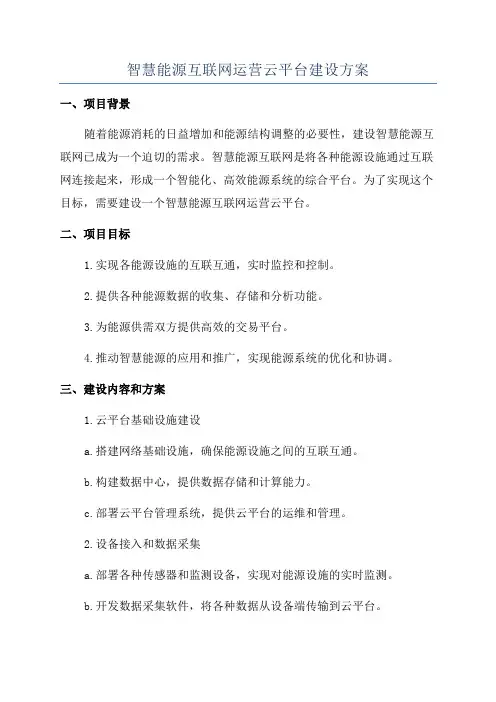
智慧能源互联网运营云平台建设方案一、项目背景随着能源消耗的日益增加和能源结构调整的必要性,建设智慧能源互联网已成为一个迫切的需求。
智慧能源互联网是将各种能源设施通过互联网连接起来,形成一个智能化、高效能源系统的综合平台。
为了实现这个目标,需要建设一个智慧能源互联网运营云平台。
二、项目目标1.实现各能源设施的互联互通,实时监控和控制。
2.提供各种能源数据的收集、存储和分析功能。
3.为能源供需双方提供高效的交易平台。
4.推动智慧能源的应用和推广,实现能源系统的优化和协调。
三、建设内容和方案1.云平台基础设施建设a.搭建网络基础设施,确保能源设施之间的互联互通。
b.构建数据中心,提供数据存储和计算能力。
c.部署云平台管理系统,提供云平台的运维和管理。
2.设备接入和数据采集a.部署各种传感器和监测设备,实现对能源设施的实时监测。
b.开发数据采集软件,将各种数据从设备端传输到云平台。
3.数据存储和分析a.建立统一的数据存储系统,将各种能源设施的数据进行存储和整合。
b.开发数据分析和处理算法,实现对能源数据的挖掘和分析。
4.交易平台建设a.设计并实现能源供需双方的交易功能,包括能源价格的确定、订单的管理和结算等。
b.提供供需双方的信息对称和自由交易。
5.系统监控和运维a.建立系统监控中心,实时监控云平台的运行情况和各能源设施的状态。
b.提供运维支持,及时处理平台和设施出现的故障和问题。
四、项目进展计划1.前期准备工作(3个月)a.完成项目组织和沟通,明确项目目标和建设方案。
b.确定云平台基础设施建设的方案和计划。
c.开展设备接入和数据采集的工作,并建立相应的数据存储系统。
2.云平台搭建和数据分析(6个月)a.搭建云平台基础设施,包括网络基础设施、数据中心等。
b.开发设备接入和数据采集的软件,并进行初步测试。
c.开发数据存储和分析的算法,并建立统一的数据存储系统。
3.交易平台建设和系统监控(6个月)a.设计并实现能源供需双方的交易功能。
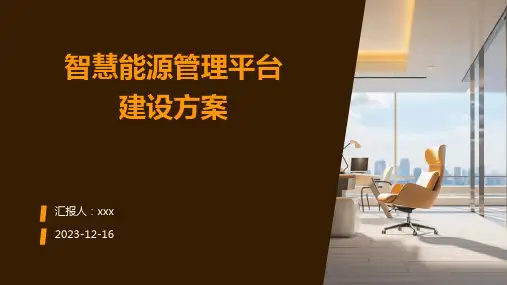
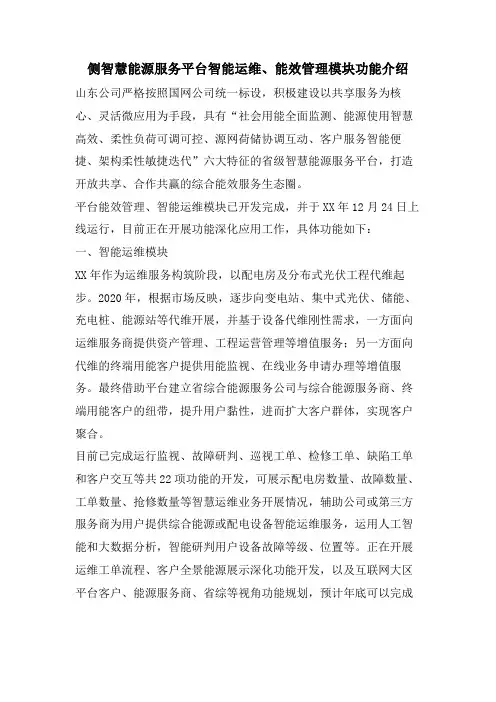
侧智慧能源服务平台智能运维、能效管理模块功能介绍山东公司严格按照国网公司统一标设,积极建设以共享服务为核心、灵活微应用为手段,具有“社会用能全面监测、能源使用智慧高效、柔性负荷可调可控、源网荷储协调互动、客户服务智能便捷、架构柔性敏捷迭代”六大特征的省级智慧能源服务平台,打造开放共享、合作共赢的综合能效服务生态圈。
平台能效管理、智能运维模块已开发完成,并于XX年12月24日上线运行,目前正在开展功能深化应用工作,具体功能如下:一、智能运维模块XX年作为运维服务构筑阶段,以配电房及分布式光伏工程代维起步。
2020年,根据市场反映,逐步向变电站、集中式光伏、储能、充电桩、能源站等代维开展,并基于设备代维刚性需求,一方面向运维服务商提供资产管理、工程运营管理等增值服务;另一方面向代维的终端用能客户提供用能监视、在线业务申请办理等增值服务。
最终借助平台建立省综合能源服务公司与综合能源服务商、终端用能客户的纽带,提升用户黏性,进而扩大客户群体,实现客户聚合。
目前已完成运行监视、故障研判、巡视工单、检修工单、缺陷工单和客户交互等共22项功能的开发,可展示配电房数量、故障数量、工单数量、抢修数量等智慧运维业务开展情况,辅助公司或第三方服务商为用户提供综合能源或配电设备智能运维服务,运用人工智能和大数据分析,智能研判用户设备故障等级、位置等。
正在开展运维工单流程、客户全景能源展示深化功能开发,以及互联网大区平台客户、能源服务商、省综等视角功能规划,预计年底可以完成功能深化和互联网大区平台相关功能建设,实现业务流转内外网一体化、各视角功能实用化。
二、能效管理模块通过采集生产类设备、能效转换及供能类设备和非生产类设备对用户侧电、水、气、热等多种能源的进行监测,基于营销系统数据、用电采集系统、用户自有采集系统、第三方接入平台和电网投资建设CPS系统的数据采集基础之上,开展用户能效管理,逐步提高用户及综合能源服务商的能效分析水平。
能源运营平台分析 2018-03-15目录一、 综合能源服务平台 (1)(一) 协鑫新能源 (1)(二) 国网电商 (1)(三) 阳光电源 (2)(四) 朗新科技 (4)(五) 用友能源科技 (6)(六) 珠海远光 (8)(七) 科陆智慧能源 (10)(八) 阿里巴巴 (11)二、 微网运营平台 (13)(九) 天合光能 (13)(十) 神华新能源 (14)(十一) 中恒云能源 (16)(十二) 深圳量子力能源 (19)(十三) 舜通智能 (21)(十四) 广州海颐 (24)(十五) 珠海派诺 (26)(十七) 烟台德联软件 (32)三、 光伏运营平台 (34)(十八) 北京国能日新 (34)(十九) 江苏爱康科技 (34)(二十) 特变电工新疆新能源股份有限公司 (35)(二十一) 远景能源 (37)(二十二) 北京木联能软件 (37)(二十三) 甘肃上航电力 (38)四、 能源管理平台 (39)(二十四) 北京东润环能 (39)(二十五) 天龙科技 (41)(二十六) 北京志诚宏业 (42)(二十七) 爱博精电智慧能源 (44)(二十八) 北京英博 (46)(二十九) 北京禄智科技 (47)(三十) 泰豪集团 (49)(三十一) 林洋新能源 (50)(三十二) 南京新联 (51)(三十四) 常州酷特 (54)(三十五) 隆基泰和 (55)(三十六) 施耐德 (56)(三十七) ABB (58)(三十八) 双良节能 (59)(三十九) 世纪楚林 (60)(四十) 恒华龙信 (62)一、综合能源服务平台传统的能源运营,主要是指电力发生/输配网络、石油/天然气管网、物流存储及相关设备的运行监控、维护检修、排险抢修等业务。
(一)协鑫新能源公司简介:协鑫智慧能源是协鑫集团旗下子公司,拥有综合利用天然气热电冷联产、太阳能、风能、低位热能、LED、储能等六种能源的“六位一体”技术平台、“鑫能网”互联网服务云平台和电力需求侧集控平台。
智慧能源解决方案智慧能源解决方案是指通过应用信息技术、智能控制等手段,对能源的生产、转换、传输、使用等过程进行全方位的智能监测和管理,实现能源的高效利用和可持续发展。
智慧能源解决方案不仅可以提高能源的利用率,减少能源浪费,还可以提升能源安全、降低环境污染等,具有重要的经济和社会价值。
在能源生产方面,智慧能源解决方案可以通过监测和分析能源生产过程中的关键指标,提升能源生产的效率和质量。
比如,在火电厂,通过搭建智能化的监控系统,可以实时监测锅炉、发电机等设备的运行状态和能效情况,通过分析数据,提供优化和调整建议,从而提高发电效率,降低能源消耗。
在能源转换和传输方面,智慧能源解决方案可以通过应用智能电网技术,提高能源的传输效率和安全性。
智能电网可以实现对电力系统的智能监测、智能预测和智能控制,通过对能源供应和需求的实时监测和调整,实现电力系统的平衡和优化。
此外,智能电网还可以实现对可再生能源的更好利用,促进可再生能源的大规模接入和消纳。
在能源使用方面,智慧能源解决方案可以通过应用智能家居技术,实现能源的智能管理和控制。
智能家居系统可以实现对家庭用电设备的实时监听和控制,比如智能电表可以实时监测家庭的用电情况,并提供用电分析报告和节能建议;智能插座可以实现对家电的智能控制,比如可以远程关闭家中的电器设备,避免不必要的能源浪费。
此外,智慧能源解决方案还可以通过应用物联网技术,实现能源设备和系统之间的互联和协同。
通过将能源设备和系统连接到云平台,可以实时监测和控制这些设备和系统的运行状态,实现能源设备之间的协同调度和运行优化。
比如,通过应用物联网技术,可以将光伏电站、风力发电场等可再生能源发电设备连接到智能电网中,实现对可再生能源的灵活调度和管理。
智慧能源解决方案的实施,不仅需要在技术方面做出创新和突破,还需要建立完善的政策和法规体系,推动能源信息化和智能化的发展。
比如,可以通过制定激励政策,鼓励企业和个人采用智慧能源解决方案,提高能源利用效率和降低能源消耗。
智慧能源管理云平台安全操作及保养规程1. 引言智慧能源管理云平台是一种通过互联网与其他能源设备进行交互的系统,采集、处理和分析数据,并提供可视化的能源管理方案。
为了确保系统的正常运行和用户信息的安全,本文档详细介绍了智慧能源管理云平台的安全操作和保养规程。
2. 系统安全操作规程为了保障智慧能源管理云平台的安全性,必须遵守以下操作规程:2.1 登录安全•使用强密码:选择密码时,应遵循复杂性要求,包括使用大小写字母、数字和特殊字符,密码长度不得少于8个字符。
•定期更换密码:为了避免密码泄露,建议每隔一段时间更换一次密码。
•避免共享账号:不要将个人账号和密码共享给他人使用。
•登录时注意环境安全:在公共场所或其他人可以看到屏幕的地方,要注意防止他人窥屏。
2.2 数据安全•定期备份数据:重要数据需要定期备份,以避免数据丢失。
•离线存储数据:重要数据可以进行离线存储,防止因网络故障导致的数据丢失。
•使用防病毒软件:定期更新并使用可信赖的防病毒软件,确保系统免受恶意软件和病毒的侵害。
•注意敏感信息的处理:不要在未加密的网络上传输敏感信息,如个人身份信息、银行账号等。
2.3 访问权限控制•分配合理的权限:给予用户适当的权限,以确保他们只能访问并修改与其工作相关的数据。
•定期审查权限:定期审查用户的权限,确保用户权限与其职责相符,并及时撤销无效权限。
•管理员账号的安全:管理员账号应设置更高级别的安全性措施,并且只有必要时才授予管理员权限。
3. 系统保养规程为了确保智慧能源管理云平台的正常运行和系统寿命,需要进行以下保养规程:3.1 硬件保养•定期检查硬件设备:定期检查硬件设备的工作状态和连接线路是否正常。
如发现异常,及时修复或更换设备。
•定期清理设备:定期清理设备的灰尘和杂物,确保设备通风良好,避免过热。
3.2 软件保养•及时更新软件:定期检查软件版本更新,并及时进行升级,以获得更安全和稳定的系统。
•定期清理垃圾文件:定期清理系统中的垃圾文件和临时文件,释放硬盘空间。
科陆新能源科陆新能源是一家专注于太阳能领域的公司,致力于提供高效、可靠的太阳能发电解决方案。
公司成立于2010年,总部位于中国上海,并在国内外设有多个分支机构,是中国领先的太阳能企业之一。
下面将对科陆新能源进行详细介绍。
首先,科陆新能源在太阳能光伏发电领域拥有丰富的经验和专业知识。
公司通过自主研发和技术创新,不断推动太阳能技术的进步和发展。
科陆新能源的产品涵盖光伏组件、太阳能电池、太阳能逆变器等多个领域,并拥有众多专利技术,保证了产品的质量和性能。
此外,科陆新能源还拥有一支高素质的研发团队,通过与国内外知名机构的合作,不断推动太阳能技术的创新,提高了产品的竞争力。
其次,科陆新能源注重产品的品质和可靠性。
公司采用最先进的生产技术和设备,确保产品的质量和性能。
科陆新能源的太阳能光伏组件经过严格的质检和测试,具有高效的光电转换效率和稳定的功率输出。
同时,公司还注重产品的可靠性,通过严格的寿命测试和环境适应测试,确保产品在各种极端环境下都能正常运行。
科陆新能源的产品经过多次国际认证,如ISO9001质量管理体系、ISO14001环境管理体系和OHSAS18001职业健康安全管理体系等,保证了产品的质量和可靠性。
再次,科陆新能源致力于推动全球清洁能源的发展。
公司的使命是通过提供可持续、高效的太阳能发电解决方案,为全球能源转型做出贡献。
科陆新能源的产品不仅在国内销售,还出口到国际市场,为全球用户提供清洁能源。
公司积极参与全球太阳能项目,与众多国际合作伙伴合作,在多个国家和地区开展太阳能项目。
科陆新能源还积极参与国内外的行业交流和合作,共同推动太阳能技术的创新和发展。
综上所述,科陆新能源是一家专注于太阳能发电领域的公司,拥有丰富的经验和专业知识。
公司注重产品的品质和可靠性,在技术创新和产品质量方面具有竞争力。
同时,科陆新能源积极推动全球清洁能源的发展,为全球能源转型做出贡献。
相信随着科陆新能源的不断发展壮大,太阳能将成为未来能源领域的重要组成部分。